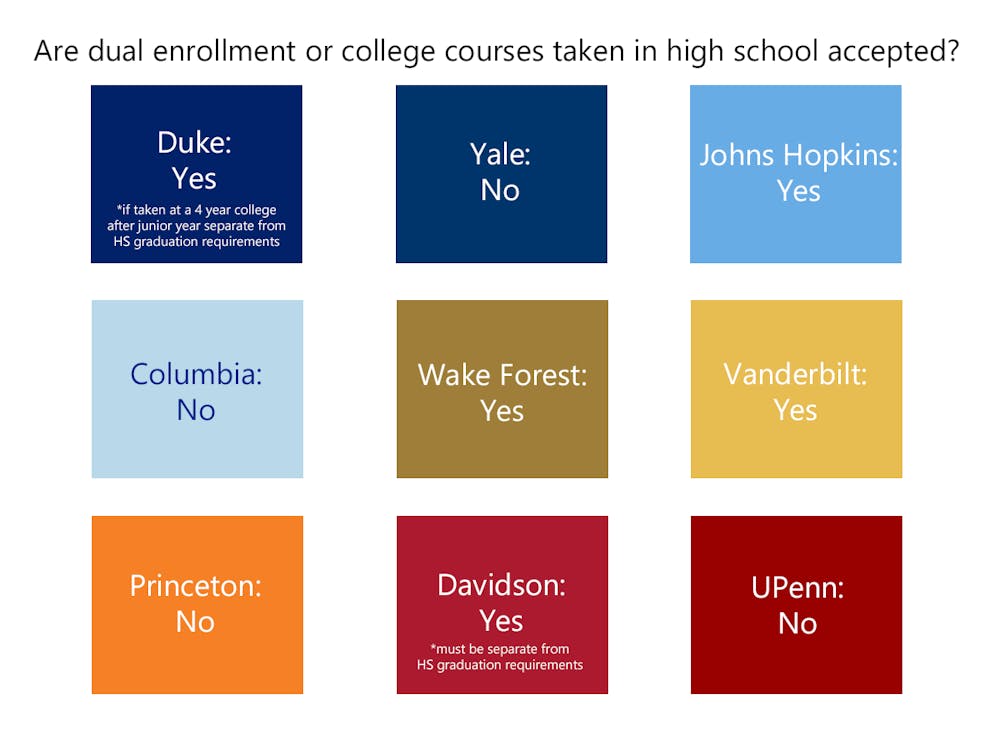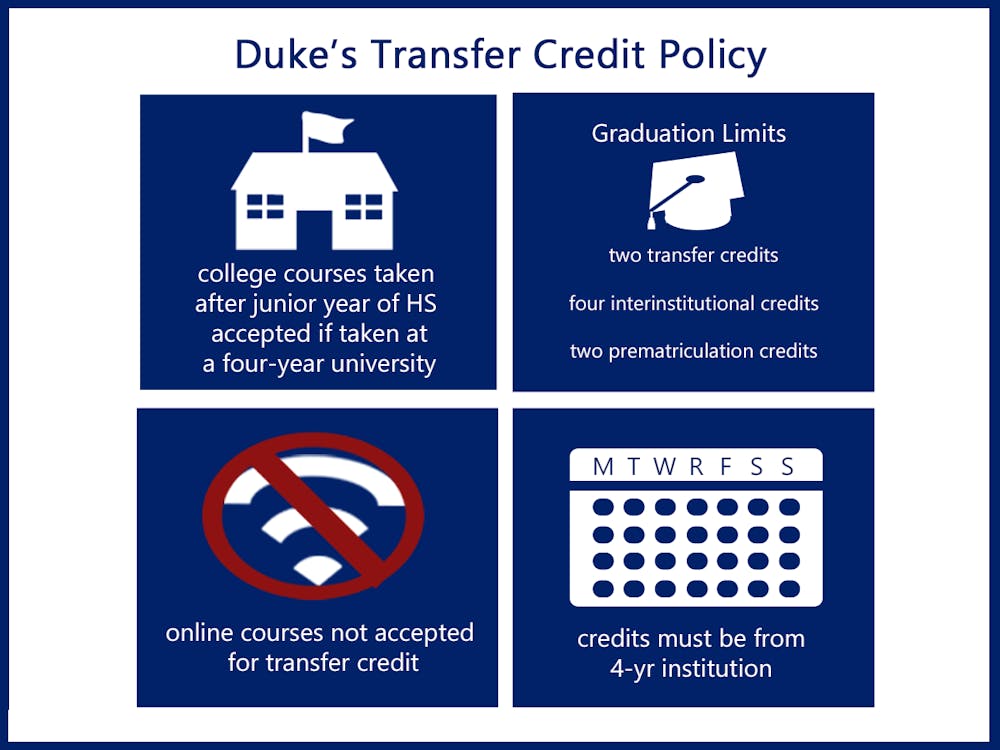Are you planning to take a community college course over the summer to get ahead on your major requirements? You may want to reconsider.
Students in the Trinity College of Arts and Sciences cannot earn credit for courses taken at a two-year institution, according to the college’s transfer credit policy. Christopher Roy, associate dean of Trinity College, said this requirement was implemented to ensure consistency in course knowledge.
“We want [transfer courses] to be comparable to a course offered at Duke or another four-year university,” he said.
The two-year institution transfer credit policy is one of many policies implemented to ensure a more uniform learning experience for students, but among those The Chronicle interviewed there are mixed opinions about its benefits. For instance, full-time college students may decide to take courses closer to home or focus on a particular area without the stress of a full course load, but these courses may not count towards graduation requirements.
Most universities have restrictions on transfer credits in order to ensure that their own academic standards are met. When compared to policies at other private institutions like Columbia, Davidson, Johns Hopkins, Princeton, University of Pennsylvania, Vanderbilt, Wake Forest and Yale, Duke’s policies yielded several similarities. Of these schools, half accept credit from two-year universities.
Angie Dewberry, registrar of Davidson College, wrote in an email to The Chronicle that Davidson removed a restriction on community college credits a few years ago and that these courses will now be reviewed on a case-by-case basis. However, some institutions stipulate that community college credits will only be accepted from incoming first-year students. Duke’s policy does not have such an exception.
Impact on first-year students
First-year Morgan DePrizio began taking college courses during her senior year of high school through a program at her local community college. This allowed her to fulfill her high school graduation requirements as well as go beyond what was offered at her school.
"I had already taken all the math classes that my high school offered, and I didn't want to take a year off of math," she said.
This led DePrizio to enroll in calculus at the community college. She hoped to get ahead on college credits in addition to meeting requirements, and she felt that, if Duke had accepted these credits, she would be able to achieve her academic goals more quickly.
"I have a lot of other requirements to do, and if I was closer it would be easier to complete those requirements, especially since I want to double major here," she said.

According to the Office of the University Registrar’s website, college courses taken after junior year of high school may be considered for transfer credit, as long as they were not part of the student’s high school graduation requirements and do have a Duke equivalent course. However, DePrizio’s calculus course was not considered because it was completed at a two-year institution.
Frank Blalark, assistant vice provost and university registrar, told The Chronicle in July 2019 about the potential “curricular challenges” of allowing students to use more AP and transfer credits when it comes to a student’s curricular experience at Duke. Blalark clarified in a December interview that credits earned before matriculation only count towards graduation, which could cause problems if students come up short on other Trinity requirements.
Only students who are graduating early can increase the amount of Advanced Placement, International Placement or Prematriculation Credit that are applied toward their degree. There is not a similar policy for transfer credits.
Going the distance

Traditional two and four-year institutions are not the only avenues for students to pursue credit, as certain universities are now offering distance education courses through online learning websites like Coursera and edX. However, some have different approaches to accepting online course credit.
For example, since Columbia does not offer online courses, students are not eligible to receive transfer credit for online courses taken at other institutions. On the other hand, Duke offers online courses during Summer Session, but online courses from other institutions are not accepted for transfer credit.
Roy said that the jury is still out on whether Duke should offer credit for online courses because of the diversity in the nature of these courses and the level of interaction between students and faculty.
“Online courses can be synchronous or asynchronous,” he said. “The faculty are still having conversations about how to evaluate these courses.”
Interinstitutional credit
If a student needs to take a course that is not offered at Duke during a specific term, they can enroll in interinstitutional courses at University at North Carolina at Chapel Hill, UNC Charlotte, UNC Greensboro, North Carolina Central University or North Carolina State University.
This interinstitutional policy is not unique to Duke. MIT allows full-time students to cross-register at Harvard University, Wellesley College and the Massachusetts College of Art and Design.
Only four interinstitutional credits can be counted towards graduation at Duke. Harvard has a similar requirement with a maximum of eight interinstitutional credits of the 128 total credits—with most semester-long classes counting as 4 credits—needed for graduation. However, Harvard students can cross-register at MIT “without limitation on the number of credits.”
“At MIT, no more than half of a student’s registration term may be taken at another institution,” wrote Jessica Zdon-Smith, assistant registrar of academic records at MIT, in an email to The Chronicle. “Therefore, if a student is taking thirty-six units at MIT, then they may not cross-register for more than eighteen units at another institution.”
In contrast, Duke students can only take one interinstitutional course per semester regardless of their course load. Blalark said that taking a significant number of interinstitutional credits would likely be infeasible for students, especially if they have to travel off-campus frequently.
“We try to make it so you can complete your major requirements at Duke,” he said, “and that you don’t have to travel to UNC to finish.”
Additionally, if a student wants to take an interinstitutional course during the summer, they must be concurrently enrolled in a Duke course. Roy said that most students enroll at UNC-Chapel Hill, North Carolina State or North Carolina Central because of proximity. However, he also said that students have transferred credits from UNC Charlotte in the past, and that courses that didn’t work out under the interinstitutional agreement could still be used as transfer credit.
Many of Duke’s peer institutions have similar restrictions on the number of transfer credits that can be counted towards graduation. In addition to the interinstitutional credit and Duke-approved study abroad program credit limits, students are limited to two transfer credits toward the 34 credits.
Roy and Blalark agreed that students who decide to pursue an education at Duke should complete the majority of their credits at Duke. Roy emphasized that the transfer credit policy, like other Trinity College policies, is decided by the arts and sciences faculty.
“Trinity takes a holistic approach to figure out how to best award credit,” Blalark said. “And that is done on a student-to-student basis.”
Get The Chronicle straight to your inbox
Signup for our weekly newsletter. Cancel at any time.

Nadia Bey, Trinity '23, was managing editor for The Chronicle's 117th volume and digital strategy director for Volume 118.

